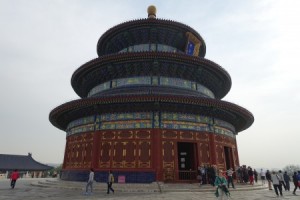 Toward the end of our stay in Beijing, we had a memorable visit to the Temple of Heaven. All of the buildings I visited were originally built in 1420. During the Ming and Qing Dynasties, the Chinese emperors would worship Heaven at this site. They would offer sacrifices to pray for good harvests and plentiful rains.
Toward the end of our stay in Beijing, we had a memorable visit to the Temple of Heaven. All of the buildings I visited were originally built in 1420. During the Ming and Qing Dynasties, the Chinese emperors would worship Heaven at this site. They would offer sacrifices to pray for good harvests and plentiful rains.
On the North side, the wall was built in a semi-circle. On the south side it was built in a square. Its layout symbolizes the belief that heaven is round and the Earth is square. The entire area is approximately 273 hectares.
Park at the Temple of Heaven
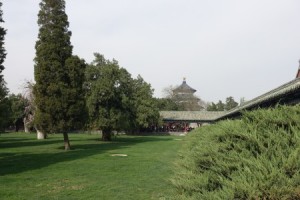
On the way to the Temple of Heaven, we walked through a parklike setting.
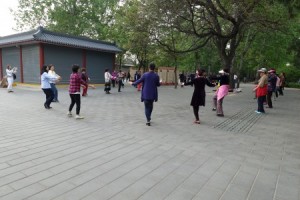
Small groups of retired people were actively engaged in simple exercises while others were playing a game that resembled badminton without a net. Most of these people were dressed in contemporary clothing.
Long Corridor
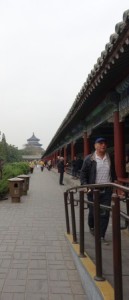
Next, we walked next to the Long Corridor. It is 5 meters wide and 350 meters long. It has 72 rooms that share the same back wall. This covered passage way connects the former Animal Killing Pavilion, the Divine Kitchen, and the Divine Warehouse. Sitting in this passageway were groups of older people playing card games and checkers, knitting, and strumming musical instruments. These people wore a mixture of traditional monochromatic Chinese clothing and western attire.

This modern usage of the space is in sharp contrast to the corridor’s original purpose. During the evening prior to the sacrificial ceremonies, this corridor was illuminated with lanterns. Goods such as jade, silk, grain, and fruit were transported along the walkway with a final destination as offerings on the altar.
The Hall of Prayer for Good Harvests
The original building was rectangular in shape and was used to worship both Heaven and Earth. In 1545, the building was transformed into a round hall with a triple eave glazed tile roof. The roof tiles of blue, yellow, and green symbolized Heaven, Earth and the mortal world.
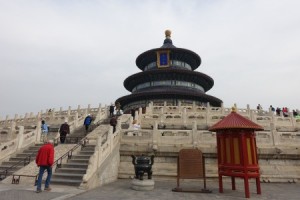
Another remodeling took place in 1751 when it was surmounted by a triple roof that had azure tiles. At this point in time, the hall was used exclusively to pray for good harvests.

The building is supported by pillars that symbolizd the four seasons, the 12 months of the year, the 12 time divisions of day and night, and the constellations. Crowds gathered to get a glimpse of the red and gold interior. Since the opening was small, short people were at a disadvantage. The above photo was taken by my tall husband. This snapshot provided my only opportunity to see inside.
This Temple of Heaven represents the only remaining example of the Mingdang architectural style. This architectural style is stunning.
Standing at the top of the stairs, I glanced back and took this photo.
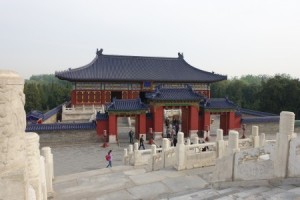
West Annex Hall and East Annex Hall
On both sides of the temple were long buildings. Originally these two structures had two rows of halls. In 1751, Emperor Qianlong removed the rear halls because he felt it caused a “disorderly arrangement”. Thereafter the front hall functioned as a place to house and worship the divine tablets of attendant gods.
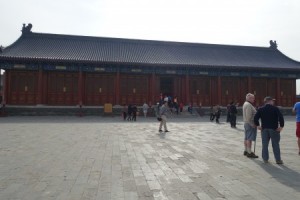
The Temple of Heaven is a tourist attraction that should not be missed. This historic place takes you back to a time when emperors felt that their sacrifices would affect the course of life on Earth. Today, modern Chinese citizens take delight in the serene atmosphere and parklike setting.
Related Posts
Sandra’s Bio
Sandra Bornstein is the author of MAY THIS BE THE BEST YEAR OF YOUR LIFE. It is available on Amazon. Sandra’s memoir highlights her living and teaching adventure in Bangalore, India. She is a licensed Colorado teacher who has taught K-12 students in the United States and abroad as well as college level courses. Sandra is married and has four adult sons. The memoir was a finalist in the Travel category for the 2013 Next Generation Indie Book Awards, the 2013 International Book Awards, the 2013 National Indie Book Excellence Awards, the 2013 USA Best Book Awards, and received an Honorable Mention award in the Multicultural Non-Fiction category for the 2013 Global ebook Awards.
Leave a Reply
You must be logged in to post a comment.